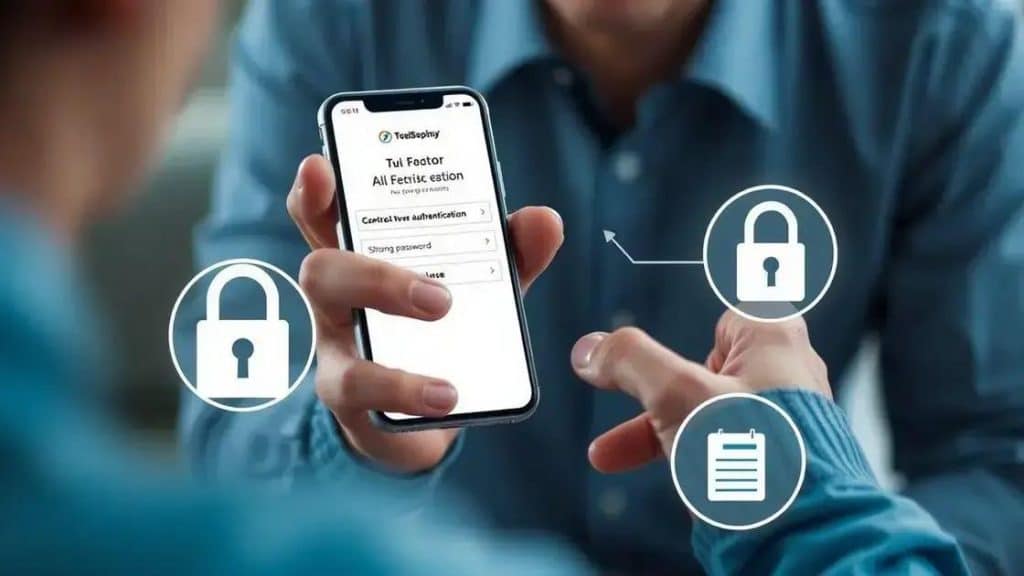Two-factor authentication for safer logins

Two-factor authentication (2FA) is a vital security feature that requires both a password and a second verification method, significantly reducing the risk of unauthorized access to your online accounts.
Two-factor authentication for safer logins is becoming a necessity for anyone concerned about online security. In a world where cyber threats grow daily, have you considered how extra layers of protection can help you stay safe?
Understanding two-factor authentication
Understanding two-factor authentication is crucial for enhancing your online security. With cyber threats on the rise, it’s essential to protect your accounts effectively. This method adds an extra layer of security, making it harder for unauthorized users to gain access.
When you enable two-factor authentication (2FA), you require not only a password and username but also something that only you have on hand. This means a hacker would need both your password and your physical device to access your account.
How It Works
Two-factor authentication typically works through:
- SMS Notifications: A code sent to your phone that you enter after your password.
- Authentication Apps: Applications like Google Authenticator that generate a code.
- Email Alerts: A code sent to your registered email address.
This multi-step process ensures that even if someone steals your password, they won’t be able to log in without the second factor. Implementing 2FA is a straightforward way to boost your security.
Many services now offer this feature as a built-in option. It’s simple to set up and typically takes just a few minutes. Adding this layer significantly decreases the risk of unauthorized access to your accounts.
As technology continues to evolve, so do cyber threats. It’s vital to remain vigilant and use every tool available. Two-factor authentication is one of the best defenses against identity theft and data breaches, helping to keep your information safe and secure.
Benefits of using two-factor authentication

The benefits of using two-factor authentication are significant and can greatly enhance your online security. By requiring a second verification method, you can drastically reduce the risk of unauthorized access to your accounts.
One major benefit is that it adds an extra layer of protection. Even if someone manages to steal your password, they cannot log in without the second factor, which greatly decreases the chances of identity theft.
Key Advantages
Implementing two-factor authentication provides several notable advantages:
- Increased Security: It’s harder for hackers to infiltrate accounts.
- Peace of Mind: Knowing your accounts are better protected brings comfort.
- Compliance: For businesses, it helps meet security regulations.
Another benefit of two-factor authentication is its adaptability. Many platforms now offer various methods for the second factor, such as SMS codes, email confirmations, or app-generated codes. This makes it easier for users to select a method they feel comfortable with.
Two-factor authentication is usually simple to set up. Most services provide clear instructions to help you get started, so you can quickly enjoy the added protection. By taking just a few moments to enable this feature, you can protect sensitive information from potential threats.
Many cyber attacks target accounts without two-factor authentication because they are easier to breach. By adding this additional step, you are making it significantly more difficult for hackers to succeed. This proactive measure not only protects you but also contributes to a safer online environment for everyone.
Setting up two-factor authentication
Setting up two-factor authentication is a straightforward process that can significantly enhance your online security. Many services offer clear guidance to help you enable this feature quickly.
To start, you usually need to go to the security settings of your account. Here, you will find an option for two-factor authentication. By selecting this option, you can follow specific prompts to add an extra layer of protection.
Steps to Enable 2FA
Here’s how you can set it up:
- Access Security Settings: Log in to your account and navigate to the security section.
- Choose 2FA Method: Decide whether you want to receive codes via SMS, email, or an authentication app.
- Enter Phone Number or Email: If you choose SMS or email, enter your phone number or email address.
- Verify Your Method: You will receive a code that you need to enter to confirm your selected method.
Once set up, the next time you log in, you’ll be prompted to enter not just your password but also the code sent to you. This ensures that you remain the only person who can access your account, making it much harder for hackers to infiltrate.
It’s essential to keep your recovery method secure. If you choose an authentication app, ensure it’s installed on a safe device. Regularly monitor your account activity to spot any suspicious behavior that might occur.
Many platforms also allow you to turn off two-factor authentication temporarily when you don’t need it. However, it’s recommended to keep this feature enabled as a best practice for your online safety.
Common mistakes to avoid with two-factor authentication

There are several common mistakes to avoid with two-factor authentication that can lead to security vulnerabilities. Understanding these pitfalls can help you maintain strong protection for your online accounts.
One frequent mistake is using simple passwords alongside 2FA. While two-factor authentication adds a layer of security, if your password is weak, it may still be easy for hackers to break in. Use passwords that are long and complex, mixing letters, numbers, and symbols.
Common Pitfalls
Here are some mistakes to be aware of:
- Neglecting Backup Codes: When you set up 2FA, you often receive backup codes. Not saving them can lock you out if you lose access to your primary device.
- Relying Solely on SMS: SMS can be intercepted, so consider using authentication apps instead for enhanced security.
- Turning Off Two-Factor Authentication: Never disable 2FA unless absolutely necessary, as it leaves your account vulnerable.
Another error is ignoring security updates. Be sure to keep your device and apps up-to-date to protect against new vulnerabilities. Updates often include important patches that help keep your accounts safe.
Lastly, sharing your authentication method can lead to problems. Whether it’s a phone number or a recovery email, keep these details private. Sharing can lead to unauthorized access.
Being aware of these common mistakes can help you enhance your security practices. By avoiding these pitfalls, you can ensure that your use of two-factor authentication truly protects your online identity.
In summary, using two-factor authentication is a crucial step in protecting your online accounts. By adding this extra layer of security, you can significantly reduce the chances of unauthorized access. Remember to avoid common mistakes like using weak passwords and neglecting backup codes. By being mindful of these practices and staying informed about the best security measures, you can keep your online presence safe and secure. Always prioritize your digital safety!
FAQ – Frequently Asked Questions about Two-Factor Authentication
What is two-factor authentication (2FA)?
Two-factor authentication (2FA) is a security method that requires two forms of verification to access an account, usually a password and a code sent to your device.
Why should I use two-factor authentication?
Using 2FA significantly enhances the security of your accounts by adding an extra layer, making it more difficult for unauthorized users to gain access.
What are common methods of receiving 2FA codes?
Common methods include SMS messages, email confirmations, and authentication apps like Google Authenticator or Authy.
What mistakes should I avoid when using 2FA?
Avoid using weak passwords, neglecting backup codes, and relying solely on SMS for codes, as these can compromise your security.





